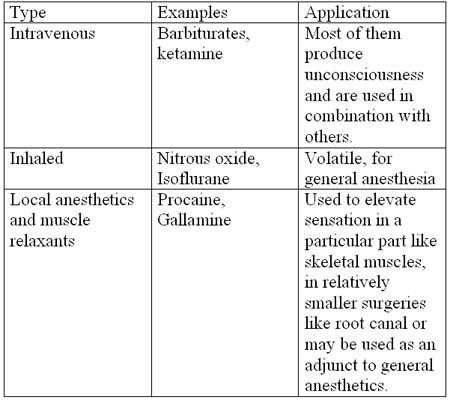Anesthesia or Anaesthesia refers to the act of blocking of the sensations, especially pain. This enables patients to undergo surgery and other procedures without stress and pain. Anesthesia can be general, meaning a total lack of awareness or it could be local, where sensation in a particular part of the body is blocked.
Anesthesia generally includes the following features:
Based on the level of Anesthesia achieved, the patient may or may not be able to maintain breathing and respiration. However, the depth of the sedation varies minute from minute. Hence, constant monitoring is required.
This includes a breathing circuit, electro cardio graph, electronic pulse clip, oximeter probe (to measure blood oxygen levels), and monitoring devices to check for hyperventilation and anesthetic levels in inhaled and exhaled air.
Throughout history, various herbal substances such as opium have bee used for relieving pain. Alcohol, and more recently, cocaine have also been used. Following are few that are currently used:
Anesthesia is administered only by Anesthesiologists, who are doctors trained in pre and post operative care or specially trained nurses. The amount, type and medium of dosage to be given have to be carefully planned based on the variables of every case. The administration of anesthetics has reached a level of precision not surmountable by modern technology and human dexterity. Hence, a whole branch of science is devoted to it and specialists needed to do the job.
In some states of anesthesia, particularly the onset and waning, the patient may unconsciously respond to verbal commands. This is used by the physician to gauge the effect of the anesthetic. So, failing doctor-patient confidentiality, it would be advisable to change your ATM-code after surgery!
Yet there are cases of ‘awareness’ during the operation, about 2 in every 1000. Because too little anesthetic would leave the patient aware and too much would kill him, a very fine balance has to be struck with just the right amount of the drug. As a result, the state of anesthesia is a very dynamic one and often patients report having memory or ‘sensations’ of the operations or actually waking up on the operation table. The scariest part is that despite being aware, the patient may not be able to communicate the fact whilst the surgeon cuts away to glory!
Other adverse effects include dizziness, muscular paralysis, fluid imbalance etc. anesthetics can prove toxic to the heart and other organs should they reach these spots. Also, individual reactions maybe seen as a result of allergies. These can be avoided by pre-operation testing.
At 1:13,000, risk of death from anesthesia far exceeds the combined risk of all the operations anesthesia is required for. Of course, one has to bear in mind that a large majority of these operations are essentially not life threatening like orthopedic surgeries. However, knowing the risk can be un-nerving when on the operating table with the lights dimming.
As already mentioned the science behind anesthesia is cutting edge. What can be done then? Apart from more comprehensive planning and post-operative care, scientists are now looking at customizing anesthesia. What this means is administering a specific dose in each case that will affect just the right area in the right magnitude. This would require a profound understanding of what exactly happens at the molecular level when a drug reacts with nerve receptors, its kinetics. Such knowledge backed by drug delivery systems would give comprehensive control to the surgeon.
Also required is detailed understanding of memory formation, retention and retrieval. Perhaps, a few years from now, patients will be able to chat with their doctor right throughout a surgery with only specific pain receptors blocked!
What you should bear in mind in the unfortunate event of having to undergo a procedure under anesthesia:
By Punit Pania


